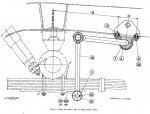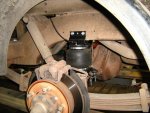I went over to parabolics about 10-11 years ago, replacing some very rusted and burst standard springs. Never having had new standard spring, I can't make any direct comparisons.
I have been very pleased with my parabolics - being TI Console HD units, they were about the most expensive on the market, but gave good handling up until my rebuild. Now, on the new 1-ton chassis and long shackles and a lot of extra weight in the vehicle (sound proofing, extra fuel tanks, a bonnet mounted spare, the roof rack and more), the raise CoG is producing more roll. IOt's not terrible when lightly loaded or empty, but is very unpleasant when heavy.
The dampers are Pro Comp ES9000s, which were fitted during the rebuild, replacing the 3000s that were fitted when I first changed to parabolics. I can see how the damping rate would affect handling in short turns and sweves, but sustained turns and side slopes need another solution.
I have three anti roll bar options:
1) 109 ambulance, using all the standard Series roll bar parts and some extended drop-mounts to fit the bar to the chassis immediately below the fuel tank (have a look at the pictures);
2) since I plan to fit a set of coiler axles (modified to suit the leaf springs), I could use the same custom drop mounts to use a standard Defender/Discovery/RRC rear anti-roll bar;
3) I could modify the exhaust so that it runs out of a side exit before entering the chassis void with the rear axle, so that a DiscoveryII anti-roll bar could be mounted on the rear face of the chassis cross member ahead of the axle (the left arm of the bar would occupy the space currently occupied by the exhaust), using custom brackets for the chassis and on the top of the axle.
Each has its own advantages and disadvantages. The best solution seems to be "number 1" because I already have everything except the drop mounts, it allows the use of standard Series axles as well as leaf-modified coil axles, and the bar is dead straight under the fuel tank. "2" would be an easy fit once the axles have been swapped, but would not permit the refit of Series axles without its loss, and the kink in the centre of the bar could foul the tank. "3" involves a lot of custom fabrication of mountings and chassis bracing, and a lot of re-routing and refabrication of the exhaust, but has the big advantage of acting as an anti-torque or anti-tramp bar if connected directly to the top of the axle with rose joints, rather than using vertical links with multiple joints.
If using the helper air springs, I was going to do so with independent inflation to prevent the air running from one to the other - even though they should help with roll a bit when connected as the down going side tries to over-inflate the upgoing side (of the body), preventing cross-feeding of the springs would give better roll control. It's an expensive solution, though, and could result in being unusably harsh except when very heavy, which would defeat the object of the excercise.
Here are some LR manual diagrams of how the ambulance roll bars fit (note the lack of a rear fuel tank):






